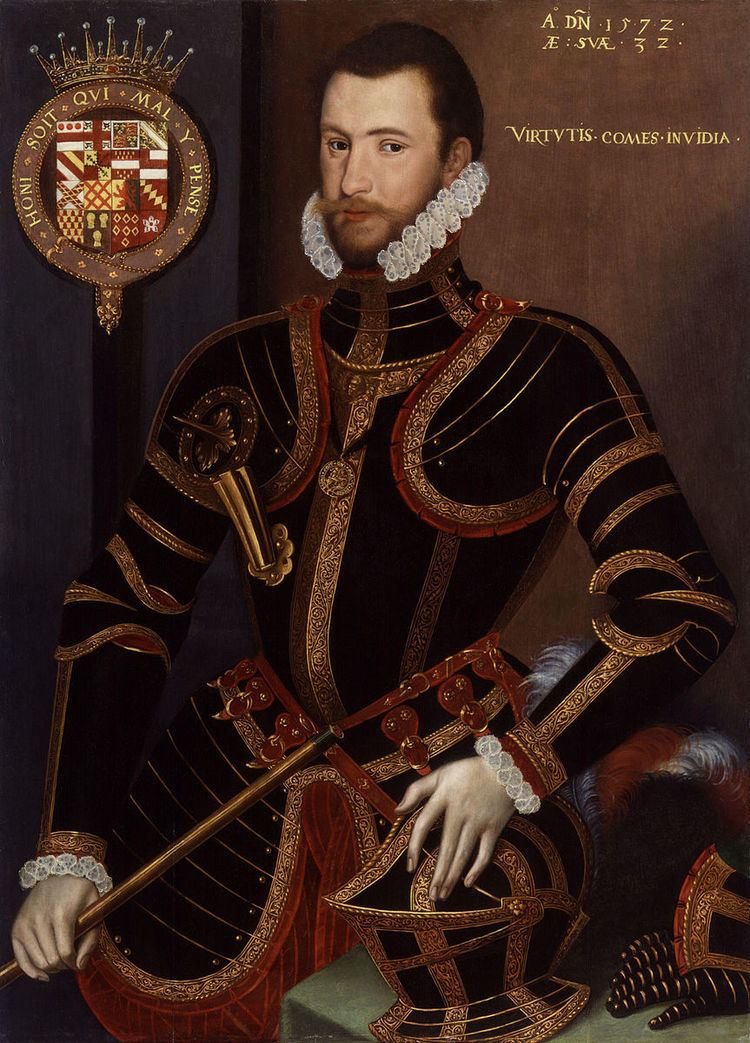Nationality English Tenure 1572–1576 | Other titles Viscount Hereford Name Walter 1st Known for Soldier and courtier | |
 | ||
Children Robert Devereux, 2nd Earl of Essex Parents Dorothea Hastings, Sir Richard Devereux Grandchildren Henry Rich, 1st Earl of Holland Similar People Robert Devereux - 2nd Earl, Lettice Knollys, Francis Knollys, Catherine Carey, Robert Devereux - 3rd Earl o | ||
Walter Devereux, 1st Earl of Essex, KG (16 September 1541 – 22 September 1576), was an English nobleman and general. From 1573 until his death he fought in Ireland in connection with the Plantation of Ulster, where he ordered the massacre of Rathlin Island. He was the father of Elizabeth I's favourite of her later years, Robert Devereux, 2nd Earl of Essex.
Contents

Family
Walter Devereux was the eldest son of Sir Richard Devereux, who was created a Knight of the Bath on 20 February 1547 and died that same year, in the lifetime of his father, Walter Devereux, 1st Viscount Hereford. Walter Devereux's mother was Dorothy Hastings, daughter of George Hastings, 1st Earl of Huntingdon and Anne Stafford, said to have been a mistress of Henry VIII. Through his paternal ancestry he was related to the Bourchier family, to which previous Earls of Essex had belonged: John Devereux, son of Walter Devereux who died at the Battle of Bosworth, married Cecily Bourchier, sister of Henry Bourchier, 2nd Earl of Essex.
Career
On his grandfather's death, Devereux became on 27 September 1558 the 2nd Viscount Hereford and 10th Baron Ferrers of Chartley. He was entrusted with joint custody of the Queen of Scots in 1568, and appointed Lord Lieutenant of Staffordshire in 1569 (which he held through the end of his life). Devereux provided signal service in suppressing the Northern Rebellion of 1569, serving as high marshal of the field under the Ambrose Dudley, 3rd Earl of Warwick and Lord Clinton. For his zeal in the service of Queen Elizabeth I on this and other occasions, he was made a knight of the Garter on 17 June 1572 and was created Earl of Essex and Ewe, and Viscount Bourchier on 4 May 1572.
Eager to give proof of "his good devotion to employ himself in the service of her Majesty," he offered on certain conditions to subdue or colonise, at his own expense, a portion of the Irish province of Ulster. At that time, Ulster was completely under the dominion of the O'Neills, led by Sir Brian MacPhelim and Turlough Luineach, and of the Scots led by Sorley Boy MacDonnell. His offer, with certain modifications, was accepted. He set sail for Ireland in July 1573, accompanied by a number of earls, knights and gentlemen, and with a force of about 1200 men.
His enterprise had an inauspicious beginning; a storm dispersed his fleet and drove some of his vessels as far as Cork and the Isle of Man. His forces did not all reach the place of rendezvous till late in the autumn, and he was compelled to entrench himself at Belfast for the winter. Here his troops were diminished by sickness, famine and desertion to not much more than 200 men.
Intrigues of various sorts and fighting of a guerilla type followed, and Essex had difficulties both with his deputy Fitzwilliam and with the Queen. He was in dire straits, and his offensive movements in Ulster took the form of raids and brutal massacres among the O'Neills. In October 1574, he treacherously captured MacPhelim at a conference in Belfast, and after slaughtering his attendants, had MacPhelim, his wife and brother executed at Dublin. He arrested William Piers, who had been active in driving the Scots out of Ulster, and accused him of passing military intelligence to Brian mac Phelim O'Neill. Essex ordered Piers's arrest and detention in Carrickfergus Castle in December 1574, but Piers was freed and he successfully executed Brian mac Phelim O'Neill for treason.
After encouraging Essex to prepare to attack the Irish chief Turlough Luineach, apparently at the instigation of the earl of Leicester, the queen suddenly commanded him to "break off his enterprise." However, she left him a certain discretionary power, and he took advantage of that to defeat Turlough Luineach and chastise County Antrim. He also massacred several hundreds of Sorley Boy's following, chiefly women and children, who had hidden in the caves of Rathlin Island in the face of an amphibious assault led by Sir Francis Drake and Sir John Norreys.
He returned to England at the end of 1575, resolved "to live henceforth an untroubled life." He was however persuaded to accept the offer of the queen to make him Earl Marshal of Ireland. He arrived in Dublin in September 1576, but fell ill at the banquet given in his honour at Dublin Castle, and died three weeks later, probably of dysentery. It was suspected that he had been poisoned at the behest of the Earl of Leicester, who married his widow two years later. A post-mortem was carried out and concluded that Essex had died of natural causes (although Alice Draycott, a judge's daughter, who drank from the same cup at the banquet, also died soon afterwards). He was succeeded in the Earldom of Essex by his son Robert.
Marriage and issue
In 1561 or 1562, Devereux married Lettice, daughter of Sir Francis Knollys and Catherine Carey. Walter and Lettice had the following children:
